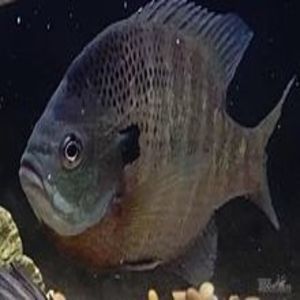 Bluegills are part of the sunfish family and are usually a deep blue and purple with olive-colored bands down the side, and a fiery orange to yellow belly. Breeding males generally have a deeper blue and orange coloration on their flanks. Adult Bluegills can be found living in deep weed beds in freshwater. Active mainly during dusk and dawn they feed on crayfish, insects, worms and small minnows. They are generally 8 inches in length though some have grown as large as 12 inches and can weigh as much as 4.5 lbs. Maximum reported lifespan in the wild is 10 years.
Bluegills are part of the sunfish family and are usually a deep blue and purple with olive-colored bands down the side, and a fiery orange to yellow belly. Breeding males generally have a deeper blue and orange coloration on their flanks. Adult Bluegills can be found living in deep weed beds in freshwater. Active mainly during dusk and dawn they feed on crayfish, insects, worms and small minnows. They are generally 8 inches in length though some have grown as large as 12 inches and can weigh as much as 4.5 lbs. Maximum reported lifespan in the wild is 10 years.
Location: Wolf Wilderness Lodge
Share:
Range
Bluegills are native to North America and lives east of the Rockies.
Habitat
Bluegills are commonly found in streams, rivers, lakes, and ponds. It usually hides around and inside old tree stumps and other underwater structures. It can live in deep and shallow waters.
Conservation Status
Least Concern
Primary Threats
Climate Change
Gestation
3-5 days
Litter
1,000 to 100,000 eggs
Behavior
Bluegills have the ability to travel and change directions at high speeds by means of synchronized fin movements. They use notched caudal fins, dorsal fins, and pectoral fins to move forward. Bluegills have a lateral line system, as well as inner ears, that act as receptors for vibration and pressure changes. However, they rely heavily on sight to feed. They also can swim backwards using pectoral fins in a rhythmic beat to balance as the movement is slower than going forwards.
Reproduction
Spawning season usually occurs in June but can be from May until August. The males arrive first and make a spawning bed of six to twelve inches. As the female arrives, he starts to make circles around her and grunting noises. The females can be selective, but if she accepts the male they go to the middle of the nest and spawn. Then the male chases the female out and protects the nest.
Wild Diet
The fish are omnivores and will eat anything they can fit into their mouth. They mostly feed on small aquatic insects and fish.
Zoo Diet

